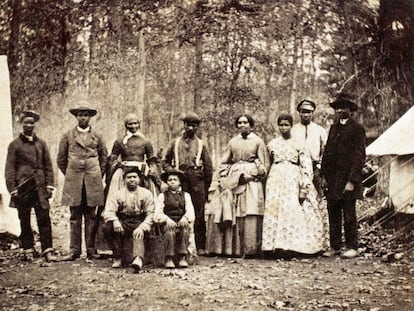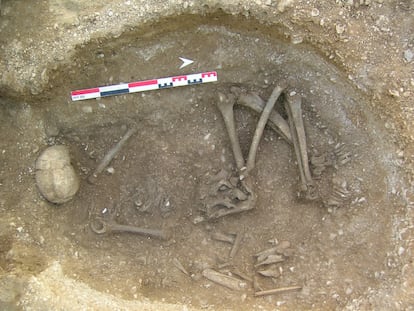Dead by 30: DNA reveals the hard life of a shepherding family 3,800 years ago
Genetic analysis of a burial in Russia’s Ural Mountains shows that while the men stayed with the tribe, the women joined other groups
One of the apparent constants of prehistory is that the men remained at the family home and the women left to join other families. A few weeks ago the largest Neolithic family tree was published with almost a hundred members excavated in France. In the two clans that were studied, the women came from outside the family groups. Now, in the far east of the European continent, the genome of a shepherding family made up of six brothers, their seven wives, children, and grandchildren has been sequenced. Their partners also came from outside the community. But in this communal burial there is a mystery: there are no women who are genetically related to the men, except for the young girls.
Anthropologists call it patrilocality, a human custom — also observed in other great apes — in which sons remain within the family group and mate with women from other groups, while daughters leave the home. Like its alternative, matrilocality, it is a mechanism to avoid inbreeding and its unwanted genetic effects. The extent of this custom at the beginning of human history is unknown, but in the few sites where science, particularly genetics, has made it possible to reconstruct the family tree, it seems the most common. The latest example comes from the southern Urals (mountain range), the natural border between Europe and Asia.
At a place called Nepluyevsky, in present-day Russia, German and Russian paleoanthropologists have excavated what is known as a kurgan, a burial mound in which one or more people are buried under a natural or artificial mound. Such burials were a common practice among many cultures in this part of the world, and there are famous ones, such as the tomb of King Midas’s father. But they could also be the last resting place of a shepherd family, like the one found in Nepluyevsky. The scientists, whose results have just been published in the scientific journal PNAS, unearthed the remains of 44 people. Continuous cracks were found in the ground, where one or more bodies had lain for almost 3,800 years. Thanks to the study of the family’s genome, it has been possible to learn what that family of shepherds was like.
The family consisted of three generations. Although the scientists were only able to sequence the genomes of 33 people, they were able to infer the position of the rest in the family tree by filling in the gaps. At the top, they identified six grown brothers, but found no trace of the founding parents. Most of the rest are children. All the adult females buried there are immigrants. According to their genes, there are even some from Central Asia, thousands of miles from Nepluyevsky. All had at least one child with one of the brothers. So, the females in the burial were either a brother’s partner or his daughters, but there are no sisters. This would indicate that it was a patrilocal family, in which the young women left the group, pairing up with men from other groups. The problem with this explanation is that it does not solve one of the mysteries of this communal grave: there are burials of adult women and young girls (under 5 years old), however, there are none between 5 and 20 years old.
No young girls
The study’s authors are not sure why none of these young women are present. Jens Blöcher, a researcher at the Johannes Gutenberg University in Mainz (Germany) and first author of the research, believes that the pattern observed in Nepluyevsky is probably the result of different burial practices for males and females: “It is quite possible that they were buried in another kurgan in the area.” “We also considered the possibility that the absence of young girls was due to an extreme form of female exogamy, with marriages arranged at a young age.” But it is an unlikely scenario, he adds, “since that would imply the presence of unrelated girls from that age group.” If unions were arranged for the girls, there would have to be girls who were not genetically related to the six brothers.
Another of the most striking aspects that the burial reveals about those shepherds is that life must have been very hard: 39% of those buried were under five years old when they died, and 57% did so before they were 15. A high infant mortality rate is typical of past societies, but not that high. These numbers cannot be considered normal, says Blöcher, “even compared to other burials of the time in the region,” he adds.
Life for the older generation was no better. Svetlana Sharapova, from the Institute of History and Archeology of the Russian Academy of Sciences and director of the excavations, recalls in a note that 3,800 years ago, “the population of the southern Trans-Urals knew animal husbandry and metallurgy, and subsisted mainly on dairy and meat products.” But in the case of these shepherds, “the state of the family’s health must have been very poor. The average life expectancy of women was 28 years, and 36 years for men”, she adds.
Genetics has also made it possible to detect a subtle but clear sign of inequality between the siblings. The firstborn, who died at the age of 55, had eight children with two different women. Joachim Burger, also from Johannes Gutenberg and senior author of the paper, recalls that “pastoral societies often show some degree of inequality, as we see with our older brother compared to the others, and are predominantly patrilineal and patrilocal.” As to whether it was the norm, Burger adds that “looking at the few studies that exist for prehistoric central and western Europe, there are no clear signs of inequality, but there are strong signs of patrilocality and female exogamy.”
Another of the mysteries that will remain unsolved is the short history of this burial. It’s not like they all died at once. In fact, there are no marks of violence or disease. But all those buried were buried within a period of no more than 15 years. Something must have happened for them to leave that place. In addition to the kurgan containing the six brothers and their seven wives, there are 37 other burial mounds in Nepluyevsky. Another kurgan has been excavated, but only the one in which the shepherding family was found has had its history revealed through genome sequencing.
Sign up for our weekly newsletter to get more English-language news coverage from EL PAÍS USA Edition
Tu suscripción se está usando en otro dispositivo
¿Quieres añadir otro usuario a tu suscripción?
Si continúas leyendo en este dispositivo, no se podrá leer en el otro.
FlechaTu suscripción se está usando en otro dispositivo y solo puedes acceder a EL PAÍS desde un dispositivo a la vez.
Si quieres compartir tu cuenta, cambia tu suscripción a la modalidad Premium, así podrás añadir otro usuario. Cada uno accederá con su propia cuenta de email, lo que os permitirá personalizar vuestra experiencia en EL PAÍS.
¿Tienes una suscripción de empresa? Accede aquí para contratar más cuentas.
En el caso de no saber quién está usando tu cuenta, te recomendamos cambiar tu contraseña aquí.
Si decides continuar compartiendo tu cuenta, este mensaje se mostrará en tu dispositivo y en el de la otra persona que está usando tu cuenta de forma indefinida, afectando a tu experiencia de lectura. Puedes consultar aquí los términos y condiciones de la suscripción digital.
More information
Archived In
Últimas noticias
Most viewed
- Sinaloa Cartel war is taking its toll on Los Chapitos
- Oona Chaplin: ‘I told James Cameron that I was living in a treehouse and starting a permaculture project with a friend’
- Reinhard Genzel, Nobel laureate in physics: ‘One-minute videos will never give you the truth’
- Why the price of coffee has skyrocketed: from Brazilian plantations to specialty coffee houses
- Silver prices are going crazy: This is what’s fueling the rally











































